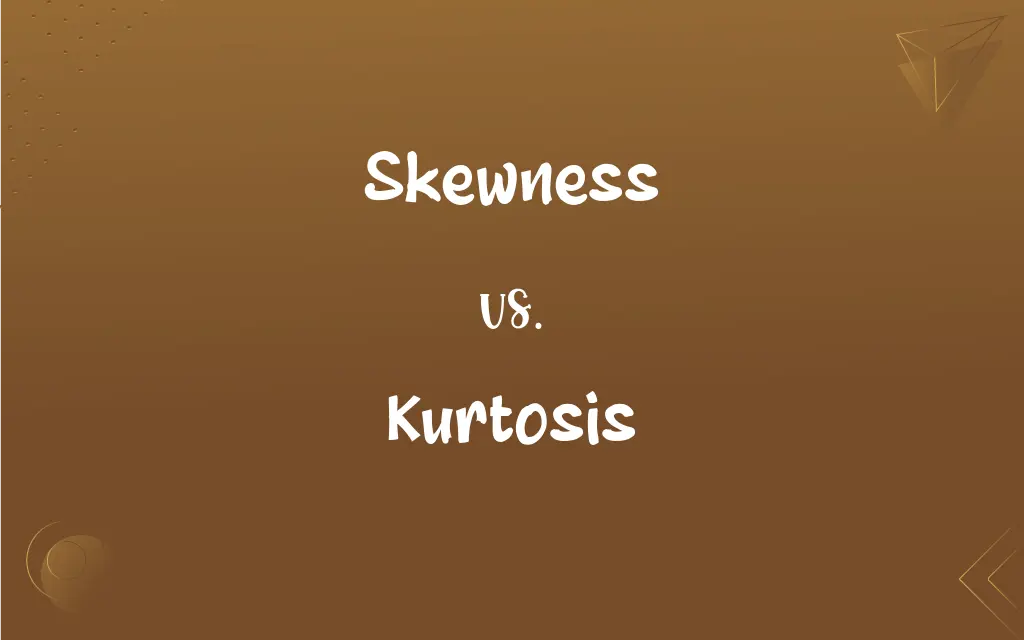Skewness vs. Kurtosis: What's the Difference?
Edited by Aimie Carlson || By Janet White || Published on December 18, 2023
"Skewness measures asymmetry in data distribution; kurtosis assesses the 'tailedness' or extremity of data distribution."

Key Differences
Skewness quantifies how much a distribution deviates from symmetry, indicating whether data tails are stretched on one side. Kurtosis measures the 'peakedness' or 'flatness' of a distribution, indicating the presence of outliers.
A skewness value of zero indicates a perfectly symmetrical distribution, whereas nonzero values suggest a skew to the left or right. Kurtosis values, in comparison, show whether data tails are heavier or lighter than a normal distribution.
Positive skewness means the tail is on the right side, showing a majority of values are low; negative skewness is the opposite. High kurtosis indicates a distribution with heavy tails and a sharp peak, suggesting outliers are more likely.
Skewness is crucial in risk management for understanding distribution asymmetry. Kurtosis is important for assessing the risk of extreme values, which can be critical in fields like finance.
In data analysis, skewness is used to adjust models for asymmetric data. Kurtosis, on the other hand, helps in identifying potential problems with outliers in datasets.
ADVERTISEMENT
Comparison Chart
Definition
Measures asymmetry in data distribution
Measures 'tailedness' of data distribution
Value Interpretation
Zero for symmetry, positive/negative skew
High values indicate heavy tails
Importance in Analysis
Indicates direction of data tail
Indicates extremity of outliers
Application
Used in risk management and data modeling
Helps identify outlier impact in data
Visual Representation
Skewed left/right graphs
Peaked/flat distribution graphs
ADVERTISEMENT
Skewness and Kurtosis Definitions
Skewness
A statistic that reflects deviation from the normal distribution.
High skewness indicated a non-normal distribution.
Kurtosis
Measure of tail heaviness in a distribution.
High kurtosis indicated more outliers in the dataset.
Skewness
Indicator of how lopsided a distribution is.
The skewness showed a rightward tail in sales data.
Kurtosis
Indicator of peakedness or flatness of data.
The low kurtosis suggested a flatter distribution.
Skewness
Measure of distribution asymmetry.
The skewness of the income data was positive.
Kurtosis
Describes the tendency of data to produce outliers.
Kurtosis was crucial in understanding the stock market's volatility.
Skewness
A descriptor of data tail length and direction.
Negative skewness meant a longer left tail in the dataset.
Kurtosis
A statistic reflecting the extremity of data points.
The kurtosis was analyzed to assess financial risk.
Skewness
Quantitative representation of distribution shape.
The skewness value was used to adjust the statistical model.
Kurtosis
Quantifies the shape of distribution tails.
The kurtosis value indicated heavier tails than a normal distribution.
Skewness
To turn or place at an angle
Skew the cutting edge of a plane.
Kurtosis
A quantity indicating how sharply a probability distribution function increases and decreases around the distribution's mean.
Skewness
To give a bias to; distort
The use of a limited sample skewed the findings of the study.
Kurtosis
(statistics) A measure of "heaviness of the tails" of a probability distribution, defined as the fourth cumulant divided by the square of the variance of the probability distribution.
Kurtosis
(statistics) Excess kurtosis: the difference between a given distribution's kurtosis and the kurtosis of a normal distribution.
FAQs
Can skewness be negative?
Yes, indicating a longer tail on the left side.
Is skewness relevant in normal distributions?
Yes, it helps determine if the distribution deviates from normality.
What does a skewness of zero mean?
It indicates a perfectly symmetrical distribution.
Does high kurtosis mean a sharp peak?
Yes, along with heavy tails.
Does skewness impact hypothesis testing?
Yes, especially in tests assuming normality.
Is high kurtosis good or bad?
It depends on the context; it can indicate higher risk of outliers.
How is skewness calculated?
Using a formula that involves the third moment about the mean.
What does right-skewed data imply?
Most values are on the lower side, with few higher values.
Can skewness be used to predict future trends?
Indirectly, as it shows distribution tendencies.
Can skewness affect statistical analysis?
Absolutely, especially in model accuracy and assumption testing.
Does kurtosis have units?
No, it's a dimensionless measure.
Can kurtosis be negative?
Yes, indicating lighter tails than a normal distribution.
What's the relation between kurtosis and variance?
Kurtosis is related but not directly proportional to variance.
Is kurtosis a measure of central tendency?
No, it measures tail extremity, not central tendency.
What does kurtosis reveal about data?
It reveals the presence and extremity of outliers.
How does kurtosis affect financial models?
It impacts the assessment of investment risk.
Should skewness be corrected in data analysis?
It often should be, to meet model assumptions.
Is kurtosis affected by sample size?
Yes, small sample sizes can lead to misleading kurtosis values.
Is zero skewness common in real-world data?
No, perfectly symmetrical data is rare in practice.
Are kurtosis values standardized?
There are standard measures, but interpretation varies by field.
About Author
Written by
Janet WhiteJanet White has been an esteemed writer and blogger for Difference Wiki. Holding a Master's degree in Science and Medical Journalism from the prestigious Boston University, she has consistently demonstrated her expertise and passion for her field. When she's not immersed in her work, Janet relishes her time exercising, delving into a good book, and cherishing moments with friends and family.
Edited by
Aimie CarlsonAimie Carlson, holding a master's degree in English literature, is a fervent English language enthusiast. She lends her writing talents to Difference Wiki, a prominent website that specializes in comparisons, offering readers insightful analyses that both captivate and inform.






































































